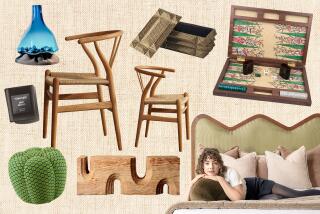Bean There, Done That so Let’s Put a Cork in It
- Share via
Many museums and collectors groups have “what’s-it” programs. Age has obscured the use of many tools and products of the past, so these unknowns are studied, and collectors try to figure out how the items were originally used.
The Enterprise Manufacturing Co., founded in 1864, made many kinds of coffee grinders, meat choppers, irons and other products. Large, floor-standing iron coffee grinders and smaller home grinders of iron and glass were both made. The company marked most of its products with its name and the patent date.
A collector has asked us about her Enterprise “what’s-it,” patented Aug. 7, 1867. It is an iron wheel and lever only 6 inches high and 12 inches long. The wheel turns, but nothing but the handle end touches the rest of the machine, so it can’t be used for cutting.
A little research shows that it is a rotary cork press. It was used by hotels to compress a cork enough to stick it back in a bottleneck. The Enterprise model was still being sold to hotels in 1905. There are many types of cork presses, some shaped like dogs or alligators. They were made of cast iron with an attractive, often bronze-colored finish. Although the original rotary cork press sold for 50 cents in the 1880s, today it is worth about $150.
*
Question I recently bought a dovetailed blanket chest made of black walnut. Mounted on the inside of the chest, on the right side, is a small box with a lid. What was the box used for?
*
Answer The small built-in container in your chest is called a till. It was a common feature in blanket chests that were made here and in Europe. The till was usually mounted on the left side of the chest. The lid of the till was held on with two dowels. When the lid was opened, it swung up and could prop open the larger chest lid. Tills were intended to store jewelry, money or other small items.
*
Q I found a Hindenburg postcard in my parents’ attic. There’s a black and white drawing of the famous zeppelin and a paragraph about its first flight. One sentence says, “This card was carried on the Hindenburg on its initial flight from Friedrichshafen to Lakehurst, N.J.” Is the postcard worth anything?
*
A Old postcards are collectibles. Yours pictures the German dirigible that made 10 successful round-trips across the Atlantic Ocean in 1936. On May 6, 1937, while landing at Lakehurst Naval Air Station in New Jersey on the first of its scheduled trips that year, the hydrogen-inflated Hindenburg burst into flames. Thirty-six of the 97 people aboard died.
*
Q We just found a copy of the first issue of Mad magazine. It says “First Issue, the New Mad” on the cover. It is dated July 1955. Is it of value?
*
A Mad was first published in October 1952. It presented a new format with the issue for July 1955. The 1952 magazine in mint condition is worth over $500; the 1955 issue is worth about $150.
*
Q What is a “ribbon doll”?
*
A Ribbon dolls were sold as household craft kits during the 1940s and ‘50s. The kits usually included a paper doll on a black background, with yards of ribbon to be sewn as the doll’s clothes. The kits were made by two companies, Bucilla Corp. of Hazleton, Pa., and Dol-Lee-Dolls of Wollaston, Mass. Collectors like to buy unopened kits, which sell for only a few dollars, or finished and framed dolls, which are priced from $25 to $60.
*
Q My family has some dishes marked “Rose China, Occupied Japan.” Who made them?
*
A In 1946 and 1947, the Noritake Co. Ltd. made china for the U.S. military forces in Japan. The war had caused shortages and the factory was unable to make china of the same quality as its earlier pieces. The company decided to use the name Rose China rather than mark pieces with its well-known trademark, which had been used since 1904. By 1949, dishes were again marked with the name Noritake.
*
Q We found an old wooden RCA Victor packing crate in our attic. On two sides of the crate there’s the familiar picture of the RCA dog, Nipper. He is staring into the speaker of an old gramophone. Would the crate interest collectors?
*
A Anything that pictures Nipper is collectible. Nipper was a real dog who was born in England. His master, Francis Barraud, painted his picture next to a phonograph and sold the painting to the Gramophone Co. Victor, an American company, was the manufacturer of the Victrola record player. The Radio Corp. of America, or RCA, bought Victor in 1929. Your crate would sell for about $150.
For a listing of helpful books and publications, include a self-addressed, stamped (55 cents) envelope to Kovels, Los Angeles Times, King Features Syndicate, 235 E. 45th St., New York, NY 10017.
Current Prices
Current prices are recorded from antiques shows, flea markets, sales and auctions throughout the United States. Prices vary in different locations because of local economic conditions.
* B&O; Railroad book, World’s Fair, 1893: $35.
* Big Little Book, Air Fighters of America, No. 1448, 1941: $50.
* Admiral AM clock radio, white plastic case, 1950s, 11 by 6 by 4 inches: $70.
* Quaker Oats Fortune Telling Calendar dated 1901, 6 by 6 inches: $175.
* Cambridge crystal flower, frog, draped lady, 9 inches: $185.
* Knickerbocker Raggedy Ann & Andy, beanbag dolls, 1971, 10 inches, pair: $390.
* Steuben cocktail set, reeded, crystal with applied mirror black threads, stopper, catalog No. 7056, fleur-de-lis on jug base, 6 handled cups: $410.
* New England dressing table, back splash with gold, green stenciled design, green and mustard grained surface, one drawer, early 19th century, 34 by 32 1/4 by 15 inches: $1,380.
* American silver salad servers, Love Disarmed pattern, Reed & Barton, 10 inches: $2,530.
More to Read
Sign up for The Wild
We’ll help you find the best places to hike, bike and run, as well as the perfect silent spots for meditation and yoga.
You may occasionally receive promotional content from the Los Angeles Times.






